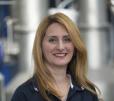

Showing 961 - 980 of 1160 results

Progress on advanced prostate cancer
Updated results show radiation therapy using lutetium-177 improved survival in advanced prostate cancer.

Role at ANSTO
Success in ARC Grants
Nanoindentation + modelling = innovation for industry
Modelling and experimentation - a powerful combination in probing mechanical properties of ion irradiated materials through nanoindentation.
ANSTO plastic trawling from Hobart to Sydney
School tours Melbourne
Come and discover the world of science at the Australian Synchrotron - book a school tour today.

Dr Santosh Panjikar is a beamline scientist at the MX beamlines of the ANSTO, Australian Synchrotron. A large part of his scientific role involves assisting scientists from the crystallography user commun

Role at ANSTO

Role at ANSTO

Helen's research interests focus on determining the thermoelastic properties and crystal chemistry of a range of minerals which are of interest in a variety of environmental, planetary geology and industrial settings.


Platypus - Neutron Reflectometer
The Platypus instrument can be used to study all-manner of surface-science and interface problems, particularly related to magnetic recording materials and for polymer coatings, biosensors and artificial biological membranes.
Transistors and NASA's radiation paradox: strength in detection, weakness in space operations
The nature of Metal-Oxide-Semiconductor Field Effect Transistors (MOSFETs) present a fascinating paradox in space exploration. Their strength in radiation detection becomes their weakness in space operations, exposing an Achilles' heel for NASA. Yet, these same devices monitor radiation doses received by humans on earth and in space.

Infrastructure - Cultural Heritage
In Australia and the Southeast Asia basin, the ANSTO facility offers a wide range of unique nuclear-beam techniques for cultural heritage research.

Role at ANSTO
Dr Meng Jun Qin is a materials scientist with expertise in computer modelling

Role at ANSTO
A closer look at the science of detecting flu
Understanding how adaptive immune cells recognise and interact with the SARS CoV-2 virus
A team of scientists led by Monash University and the University of Melbourne in association with the Peter Doherty Institute for Infection and Immunity have made progress in clarifying the molecular interactions that underpin how our adaptive immune cells recognise SARS CoV-2, which causes COVID-19.